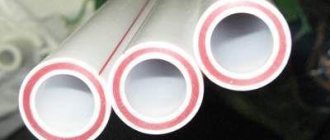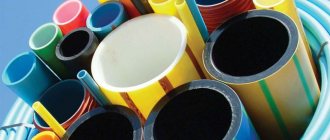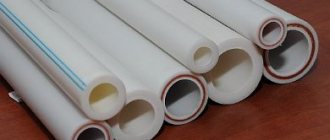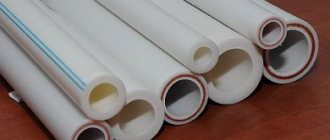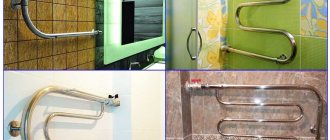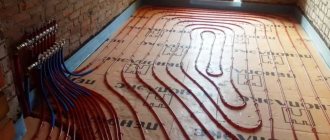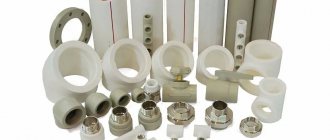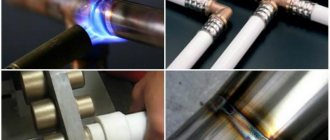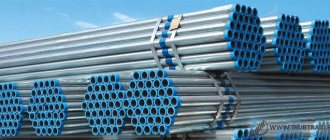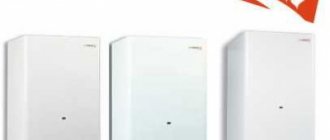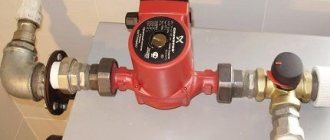When arranging autonomous heating and hot water supply, it is extremely important to correctly select materials for the pipeline. Pipes must not only comply with operating conditions, but also be conveniently installed using all available methods. Let's look at what a fiberglass-reinforced polypropylene pipe is, what its pros, cons and scope of application are, what types there are, how it differs from its aluminum-reinforced counterpart, and what options for its installation exist.
Polypropylene reinforced pipes are used for heating systems Source antagroup.ru
Reinforced polypropylene pipe - what is it, features, application
As in any other area of everyday life, polymer materials are successfully replacing metals in the construction of heating and water supply systems. The advantage of polypropylene pipes is their inertness to corrosion, sufficient mechanical strength, light weight and ease of installation. However, along with such obvious advantages, they also have significant disadvantages - deformation under the influence of heat and pressure of the pumped medium.
It is enough to supply hot water under pressure so that the water supply system made of such material is deformed. The consequences of such an event will be deterioration of aesthetics, destruction of finishing and leakage of plumbing. Reinforced polypropylene does not have all these disadvantages. Moreover, the material is superior in performance characteristics to analogues in which aluminum is used as a reinforcing layer.
Conventional polypropylene pipes can deform when heated Source ytimg.com
Structurally, the polypropylene tube of the type under consideration is a 3-layer structure - polypropylene-reinforced layer-polypropylene. The reinforcing layer can be made of either pure glass fiber or polypropylene stitched with glass fibers. At the same time, the composition of the material is monolithic - the production technology ensures absolute adhesion of the interlayers.
Pros, cons, application
The use of polypropylene pipes with fiberglass reinforcement for water supply has the following number of advantages:
- No corrosion. The material does not rust not only when pumping water, but also almost any coolant used in everyday life.
- Durability. If the operating standards are observed, the pipes do not require replacement throughout their entire service life. They last at least 4 times longer than their metal counterparts.
- Minimum thermal conductivity. Thanks to this, the pipes not only do not contribute to the loss of heat from hot water or coolant, but also do not form condensation.
Polypropylene pipes do not rust and do not form condensation Source ytimg.com
- Reduced operating noise. A polypropylene pipe with fiberglass practically does not allow sounds generated by the operation of the water supply or heating system.
- Inertness to coolant freezing. If the pumped medium suddenly freezes, the pipeline, due to its low susceptibility to expansion, will not suffer damage, unlike its metal counterparts.
- Easy to install. Polypropylene is easy to process, and the presence of a variety of fittings greatly simplifies the work of the installer.
- Sealing of joints. When using the sleeve welding method, leaks are completely eliminated.
- No deposits on the internal walls. The high degree of smoothness and resistance to corrosion prevent the formation of build-up and deposits, due to which the pressure indicator remains stable throughout the entire service period.
- Inertness towards substances with chemically aggressive properties.
- Minimal maintenance. Pipes do not require painting or repair, so they can last for several decades without replacement or restoration.
With proper installation and operation, polypropylene pipes will never require repair or replacement Source ytimg.com
See also: Catalog of companies that specialize in engineering systems (heating, water supply, sewerage and others) and related work
Among the shortcomings of the material, the following most often appear:
- The need for pre-installation treatment. Some types of pipes require trimming before joining.
- Insufficient mechanical strength. Polypropylene pipelines do not have the same resistance to external damage as their metal counterparts. Therefore, in problem areas they need to be mounted in protective boxes.
- Limited bending during installation. It is recommended to use only the fitting - without bending it at turns.
The main area of application of fiberglass-reinforced polypropylene is the installation of pipelines for heating and hot water supply systems for a private home with stable temperature and pressure parameters. In addition, pipes based on it are often used in specific plants when pumping aggressive media is required, as well as in the food industry.
On a note! If the coolant enters the house from a centralized main, it is better not to use polypropylene pipes, even with reinforcement. Since instability of characteristics and water hammer will quickly disable such a pipeline.
Polypropylene pipes are intended for private heating systems Source blog-potolok.ru
Reinforcement inside
As a result, some changed the technology for manufacturing multilayer pipes. Others use modified glue. Still others hid the aluminum layer inside the pipe.
Still others left the reinforcement on the outside, but the aluminum foil became perforated.
So what about the reliability of such a puff pastry? In the case of reinforcement in the middle of the pipe, there is still a potential risk of swelling of the layers. But it will not be visible to the user.
With such small swellings inside the pipe, the system will continue to work and the user will never know about it. But there is one thing. On one side, the layer of polypropylene between the reinforcements is quite large. It is much more difficult for such a layer of polypropylene to swell. But even if such swelling occurs, it will not be noticed throughout the entire operation of the system. But on the other hand, a serious problem can arise with such a system if an error is made either in the calculations of the system or during operation of the system.
Let's assume that a system is installed where a relief valve is installed (an emergency valve that relieves pressure), an expansion tank is installed and everything else. This system works properly and for a long time. Let's say 5 years have passed. The maintenance of this system has long been abandoned because no one knows that it needs to be maintained. The air from the expansion tank has long been released and the moment has come that either from the city network or the boiler is overheated, if it is a solid fuel boiler and 90° or 110° has flown into the system. At this temperature the pipe will not burst. Why it won’t burst, see the first paragraph of the PP course. At this moment the water expands. The water expanded and the relief valve activated. A relief valve drained excess water to prevent the system from rupturing. What will happen next? And then the system will cool down. If the system cools, then the water decreases in volume. If our expanzomat does not work, then where will the water come from if we do not have automatic replenishment? That's right. A vacuum will form in the system. So, during such a severe vacuum, weak sections of the pipe can collapse inward and completely block the coolant flow.
By the way, write in the comments whether you have encountered problems with swelling, both from the outside of the pipe and inside, and whether you have had to redo systems where the polypropylene pipe collapsed inside. If there are such, then also write the manufacturer.
With this post I do not want to say that a pipe reinforced with aluminum in the middle of the pipe is bad. I just want to say that if you make such a mistake during operation of the system, then such a pipe will most likely not forgive you for such a mistake. And you will have to pay very dearly for such a mistake. Outside minus 40, the heating system does not work. By the way, with such gross errors during installation or operation of the system, not only a polypropylene pipe can collapse. Therefore, be careful.
But the perforated foil, which is located on the outer layer of the pipe, does not have such a drawback, because inside there is a thick layer of polypropylene and in order to flatten it you need a very large vacuum. And swelling on the outside turned out to be a much rarer occurrence.
It turns out that the aluminum layer is held in place not only by the glue, but also by the fact that polypropylene is welded to polypropylene through these holes. The pipe looks and feels so pimply. But reliable.
In view of all this, we get the disadvantages of a pipe that is reinforced with aluminum. First, the outer layer may swell and lose its appearance.
The outer layer must be cleaned before welding. Installation becomes more complicated.
The inner layer also needs to be trimmed before welding.
The inner layer of polypropylene can block the passage in case of an error.
In view of these difficulties, another method of reinforcing polypropylene pipes was developed.
Varieties
There are the following types of polypropylene pipes:
- Single layer.
Divided into 4 types:
- PPN. Consist of homopropylene. Used in networks without loads - for cold water, ventilation, engineering systems.
- RRV. Made from polypropylene block copolymer. Purpose: heated floors, cold water supply.
- PPR. It is based on random polypropylene copolymer. The outside is coated to protect against UV rays. The main feature is the uniform distribution of the load on the walls. It is used in both cold and hot water supply, as well as in heating systems.
- PPs. The base uses a heat-resistant polymer. Thanks to this, the pipeline can withstand heating up to 95 °C, and, if necessary, short-term overheating up to 110 °C.
The first 3 modifications are operated at a temperature of the pumped medium not exceeding 70 °C. In fact, all 4 types of material do not contain a reinforcing layer, but are only a type of ordinary polypropylene.
Polypropylene pipes exist in various modifications, but the most reliable and durable of them are reinforced Source obzor-expert.com
Fiberglass or aluminum - comparison of characteristics
When choosing polypropylene pipes for heating, the buyer often has a question about which type is better - reinforced with fiberglass or aluminum. The answer to this question can be given by comparing the following similar characteristics:
- Reliability. Fiberglass forms a monolithic structure, while the aluminum counterpart is glued, which is especially reflected at joints that require high-quality welding.
- Diffusion properties. The fiberglass variety does not allow oxygen to pass through and does not undergo oxidation. In contrast, pipes with aluminum can be subject to corrosion at the weld seam.
The convenience of pipes with fiberglass lies in the possibility of easy installation with various fittings Source vyborexperta.ru
- Heat loss. The option with fiberglass has minimal ability to lose heat compared to those with an aluminum layer.
- Resistance to aggressive environments. Both options are inert.
Important! Unlike the fiberglass analogue of the pipe, the contents of aluminum foil must be carefully cleaned at the ends. Otherwise, the connection will be of poor quality and will leak quickly. This installation technique is only available to a professional with extensive experience. Anyone can install a fiberglass pipeline.
Reinforcement methods
There are two technologies for reinforcing PPR pipes:
- fiberglass;
- aluminum foil.
Foil reinforced pipes
Metal
The essence of this technology is that aluminum foil is sealed inside the part. The ends of the metal are soldered together. There are three types of tube reinforcement using aluminum:
- pipe walls consist of 3 or 5 layers;
- foil is solid or reshaped;
- the location of the reinforcing layer is closer to the outer edge of the part or in the middle.
fiberglass
Fiberglass is loose fibers, not a solid material, which is why the technology used to reinforce tubes with it differs from soldering a layer of aluminum foil. Fiber fiber is located inside the part and mixed with polymer.
Mounting options
The method of installing a fiberglass-reinforced polypropylene pipe is largely determined by the characteristics of the pipeline being installed and the ease of installation in specific conditions. Due to the fact that the products of this type do not contain a metal layer, they are fastened using standard techniques for polypropylene:
- Threaded fitting.
- Cold welding.
- Diffusion welding.
In this case, welding of pipe sections must comply with the following series of requirements:
- Compliance with safety regulations.
- Following the technology - the use of 2 nozzles, internal and external, and their simultaneous heating.
- Ensuring complete immobility of the joined parts - without scrolling to avoid deformation.
- Ensuring uniform arrangement of connected elements.
- Fixing the ends of the segments to be fastened for at least 30 seconds.
Recommendation! When choosing pipes for heating systems, preference should be given to products marked PN25. The number indicates the pressure value - in this case 25. Moreover, according to the operational characteristics, it corresponds to a temperature of the pumped medium of 95 °C.
Briefly about the main thing
Reinforced polypropylene pipes have a 3-layer structure, along the edges of which there is the polymer itself, and in the middle there is fiberglass. Among its main advantages when used in water supply and heating systems are:
- Anti-corrosion.
- Long service life.
- Low heat loss.
- Minimum operating noise.
- Resistance to freezing.
- Ease of installation.
- Connection density.
- No growths or deposits on the walls.
- Chemical inertness.
- Minimal maintenance.
Disadvantages are associated with the need for pre-installation processing, low mechanical strength and limited bending during installation. Reinforced polypropylene is used primarily for hot and cold water supply and heating in private homes.
Polypropylene pipes are divided into single-layer and multi-layer. When compared, products with fiberglass reinforcement turn out to be better than analogues with aluminum protection. Installation is carried out in 3 ways - threaded fitting, cold and diffusion welding. In this case, the welding procedure must be carried out in accordance with special requirements.
Main pipe diameters according to GOST
The diameter in the marking of PPR water pipes is indicated as the outer diameter. Moreover, the larger it is and the higher the PN, the thicker the pipe wall. Products of 16–20 mm are used for installing water pipes throughout the apartment and cottage. 25–32 mm is for the riser. Larger diameter options are intended for pipelines in multi-storey buildings, main networks and sewerage.
How to correctly calculate the diameter of a pipe based on its purpose
